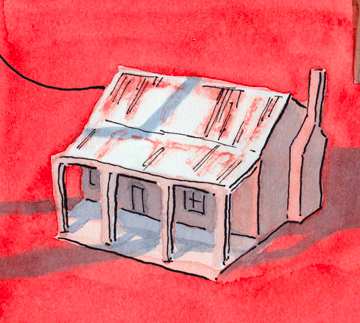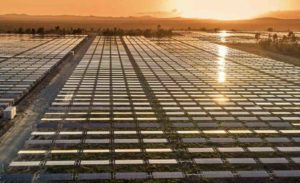Last year, some friends moved into the new three-bedroom home they had built on semi-rural block of land in northern NSW. Despite being within three kilometres of a large town, and with the power network running along the local road, they chose not to connect to the grid.
The local government-owned network operator wanted $30,000 to run a wire about 50 metres to the house. My friends decided they were better off spending that money on solar panels and a battery array.
They won’t have another electricity bill, and probably won’t need to spend anything more until the batteries need replacing in at least 10 years time, by which time battery storage costs might be a fraction of what they are now. They also bought a small generator as back-up, but despite moving in to the house in late autumn, they have yet to switch it on.
Theirs is a story being shared by thousands of people around the country, including Greens leader Senator Richard Natale, who lives in a rural block outside Melbourne, also unconnected to the electricity grid for the same reason.
People have been making these decisions for decades. But now – because of the falling cost of battery storage, the publicity surrounding the Tesla brand, and the rising cost of the grid, it has become a mainstream issue.
But it’s not just new and rural homes that are eschewing the traditional network for cheaper options. New suburbs and sub-divisions are being proposed that will not be connected at all, preferring instead to rely on micro-grids relying mostly on renewable energy and storage. Retirement communities – keen to lock in and control costs – are considering doing the same.
Property develop LWP is teaming up with Canadian giants Brookfield and Flow Systems to develop an off-grid community called Huntlee near Newcastle. Leading economist Ross Garnaut is chairing a new company called Zen Energy that is looking to do similar things in South Australia.
“Households, businesses and entire communities can now become genuinely self-powered completely or substantially depending on their circumstances and preference. Australia’s energy transformation has begun,” Garnaut told the ABC’s 7.30 Report last year.
And that means existing homes and townships too. In northern NSW, such as Tyalgum and the whole Byron Bay shire, are considering proposals to “buy back” the grid.
Network operators – such as South Australian Power Networks, Ergon Energy, and Western Australia’s Western Power and Horizon Energy, admit that taking regional towns off the grid is not such a bad idea. It avoids the immense cost of extended power lines, it increases energy security, it allows local renewable energy sources to be efficient integrated into the local area, and it saves money.
Indeed, Ergon CEO Ian McLeod last year admitted that if the networks had to build the grid from the ground up now, it would look a lot different. His company has publicly canvassed the idea of cutting costs by taking homes off grid in regional areas.
But the grid has already been built. And what really scare the network owners – both private and government – is the potential of a mass exodus by home owners in the city from the established grid as the cost of rooftop solar and battery storage technologies continue to fall.
Firms such as UBS have suggested that such a move would be economic before 2020. Debate rages about the payback times for going off grid, or just installing battery storage. In reality, it depends on so many variables – the location, the orientation of the roof, the consumption pattern of the users, and the local tariffs.
Some people will care about payback times, but some people won’t. What, after all, is the payback of your car, or your sofa, or your swimming pool. Most people don’t know or don’t care. If they want something badly enough, they will buy it. And for many, the idea of energy independence, or energy democracy is an appealing one.
Needless to say, the networks are not happy. Paul Adams, the head of Jemena, owned by Chinese and Singapore interests and which owns a transmission network in Victoria, accused households of wanting to quit the grid of being “greedy and selfish.”
“The grid is of so much value here, why don’t you want to share your energy with your neighbours,” he is reported to have said.
Adams later apologised for his comments, saying that people had the right to do what they want. But he had and has a point. If the grid is there, then why wouldn’t you want people to use it.
The answer lies in the “greed” of the network operators and owners themselves. For the past decade, they have been unfettered by strong regulatory review, and have been delivered a perverse incentive scheme that encouraged them to build bigger, longer and dumber networks.
As a result, the operators have massively overspent and Australians have been saddled with what is undoubtedly the most expensive grid in the world. Australia may have cheap coal power, but it has the most expensive delivery system. It costs a householder as much to boil a kettle in the early evening in any major city as it would using a diesel generator in an outback town.
The networks have been warned of the consequences. A report by CSIRO, prepared in conjunction with the industry, and updated late last year, warned that one third of all consumers could quit the grid in the next decade or two unless the networks did something about costs, and changed their business models.
But despite talking about the push to green energy, and sounding supportive about solar and battery storage, most networks have done very little to change so far.
In fact, they have been mostly focused on protecting their revenue flows, proposing a range of rule changes – including higher fixed tariffs, extra charges for solar households, and rules designed to prevent the installation of battery storage – to make it less attractive for households to install new technologies. The regulators have obliged by deferring new incentives that could encourage them into new technologies and new ways of thinking about the grid.
The networks lobby – while lauding the advent of new technology on one hand – has refused to admit that too much money has been spent building a big grid unsuited for the digital age, or that its members should write down the value of those assets. Yet it has even proposed to hit households with a fine or compulsory fees if they quit the grid. Or they’ll do what? Disconnect them?
There is no doubt the more efficient outcome is for people to remain on the grid. It’s a social benefit and it should be shared. It would be the most economic efficient outcome, but as Garnaut points out, that doesn’t hold true when the networks are pricing themselves out of the market, and not responding to new technologies.
To survive, the networks have to adapt and they have to change. Kodak ignored its own development of digital photography and paid the consequences. Australia Post is trying to charge $1 a letter now in face of competition from email and other social media. Many houses have already dumped their telephone landline.
The same thing will happen with the electricity grid. And the more the networks load up costs on to remaining households to protect their revenues, the more opportunities there will be for alternative technologies and alternative business models to service that market.
Yes, people should be encouraged to stay on the grid, so long as it is priced properly. Saying that households or communities should not pursue cheaper options off grid is a bit like asking them to forego emails for the sake of sending a letter, use camera film instead of digital photos, eschew mobiles in favour of a landline. Technology marches on. And the networks will have no one to blame but themselves.
Greg Foyster’s cartoons can be found here.









